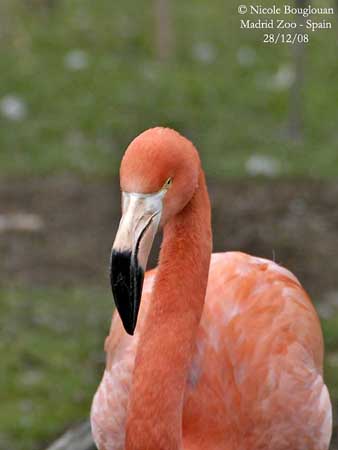
Fr: Flamant des Caraïbes
All : Rosaflamingo
Esp: Flamenco
Ital: Fenicottero
Nd: Caribische Flamingo
Sd: Karibisk flamingo
Port: Flamingo
Photographers:
Alfredo Colón
Puerto Rico Wildlife
Jean Michel Fenerole
Photos d’Oiseaux du monde
Jean-Claude Jamoulle
A la rencontre des Oiseaux
Nicole Bougloouan
PHOTOGRAPHIC RAMBLE
Text by Nicole Bouglouan
Sources:
HANDBOOK OF THE BIRDS OF THE WORLD vol 1 by Josep del Hoyo-Andrew Elliot-Jordi Sargatal - Lynx Edicions - ISBN: 8487334105
A GUIDE TO THE BIRDS OF MEXICO AND NORTHERN CENTRAL AMERICA by Steve N. G. Howell, Sophie Webb - Oxford University Press - ISBN: 0198540124
A GUIDE TO THE BIRDS OF COLOMBIA by Steven L. Hilty and William L. Brown - Princeton University Press – ISBN 069108372X
L’ENCYCLOPEDIE MONDIALE DES OISEAUX - Dr Christopher M. Perrins - BORDAS - ISBN: 2040185607
BirdLife International (BirdLife International)
Toronto Zoo – Same planet. Different world
Welcome to WhoZoo (Jill Foley)
What Bird-The ultimate Bird Guide (Mitchell Waite)
Wikipedia, the free encyclopaedia
American Flamingo
Phoenicopterus ruber
Phoenicopteriforme Order – Phoenicopteridae Family
INTRODUCTION:
The American Flamingo and the Greater Flamingo (P. roseus) are the largest flamingos of this family. They were formerly considered a single species. But today, they are treated as two separate full species.
The American Flamingo is the New World race, whereas the Greater Flamingo is the Old World species.
There is an isolated population in Galapagos Islands, occasionally considered a separate subspecies “P.r. glyphorhynchus”, with some differences in coloration and size.

DESCRIPTION OF THE BIRD:
Biometrics:
Length: 120-145 cm
Wingspan: 140-165 cm
Weight: M: 2800 g – F: 2200 g
The adult has bright pinkish-red to coral-red plumage, especially on head, neck, breast and tail. Back and underparts often appear paler, pale pink to white.
When the bird is flying, the black primaries and secondaries flight feathers are conspicuous.
Both sexes are similar.
The bill shows the typical downwards bend. It has pale yellow or whitish base. The middle is pink to orange and the tip is black. The eyes are yellow with red inner eyering and whitish outer eyering. The very long legs are pale pink with darker joints. The feet have webbed three front toes and a short hind toe.
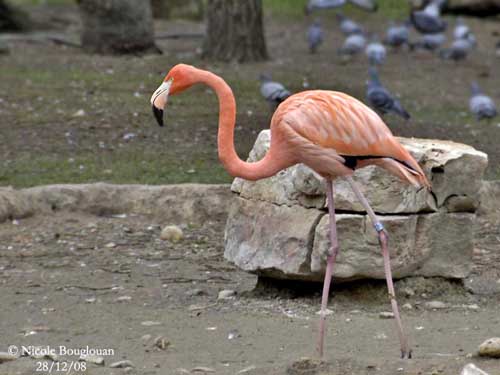
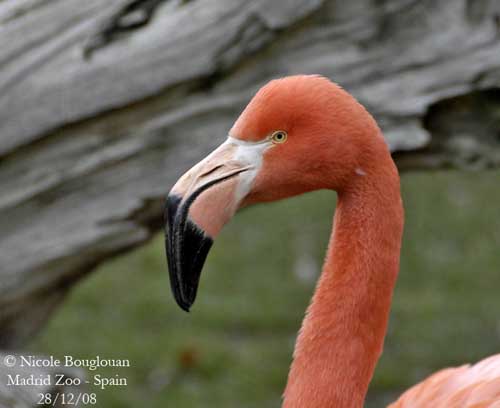
The juvenile has grey-brown plumage with pinkish wash in underparts. Wings and tail are mainly brown with black flight feathers. The bill is pale blue-grey with black tip. The eyes are dark greyish. Legs and feet are grey with blackish joint.
The subadult plumage may vary during the first three years. It is usually sexually mature at 5 years old.
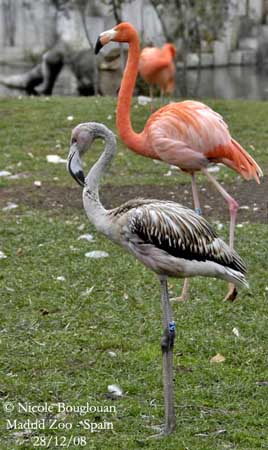
However, the adults vary in colour too, from white or pink to red. Their feathers become red thanks to the carotenoid found in their food, both crustaceans and algae. With a different diet, the flamingos could be white!
SUBSPECIES AND RANGE:
The population which occurs in Galapagos Islands is considered a subspecies. Its scientific name is P.r. glyphorhynchus and the English name is Galapagos Flamingo.
It frequents brackish lagoons in the lava fields behind the coasts, and it breeds there, in small colonies of 5-50 pairs.
This subspecies is evaluated as Endangered, due to El Niño en 1983. There are about 500 individuals in Galapagos.
The American Flamingo P.r. ruber is found in Caribbean islands, but also along the coasts of Colombia and Venezuela where it breeds. It is also found in Yucatan Peninsula, and occasionally in Florida, along Gulf coasts.
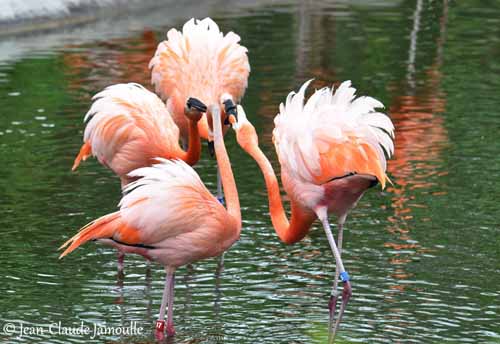
HABITAT:
The American Flamingo frequents saline lagoons and freshwater habitats, including mudflats, estuaries, coastal and inland lakes.
CALLS AND SONGS:
The American Flamingo is noisy like all flamingos. The voice plays an important role in keeping the flocks together. The sounds may vary according to each activity, and usually are low gabbling produced by feeding flocks, and nasal honking given during the flight. Courtship displays are accompanied by grunting and growling.
The larger flamingos like this one, have lower-pitched voice than the smaller species and utter mostly goose-like calls.
The voice is very important during the nesting period for the mutual recognition between parents and chicks.
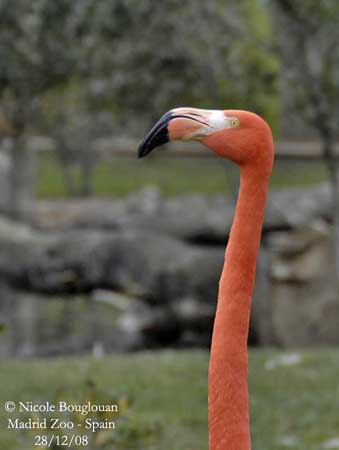
BEHAVIOUR IN THE WILD:
Like other waders, the American Flamingo stirs up the mud with its feet to disturb preys. Then, it sucks the water through the typical bill, well adapted to filter out the small aquatic preys such as shrimps, molluscs and various microscopic organisms. It also feeds on seeds and algae in the same way.
It feeds by wading with the head lowered in the water. The bill is held horizontally and pointing backwards. It sucks water and mud in and out, 5-6 times per second. Thanks to the tongue and the lamellae, it filters and retains the food items.
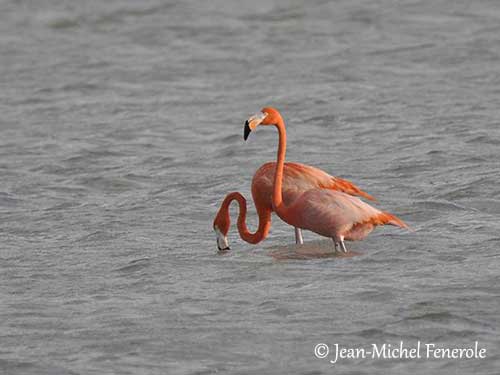
It also feeds while swimming and may upend like ducks by paddling with the feet to maintain the position. This large flamingo can reach down 120-130 cm, allowing it to find more available food.
When the amount of food is reduced, the American Flamingo moves to another feeding area, sometimes in the same lake or lagoon, and waits for the recovery of the exploited zone.
The American Flamingo spends most of the day feeding. They live in large social groups. These shy birds fly away if disturbed. The main activities of both adults and immature birds are feeding, preening and resting.
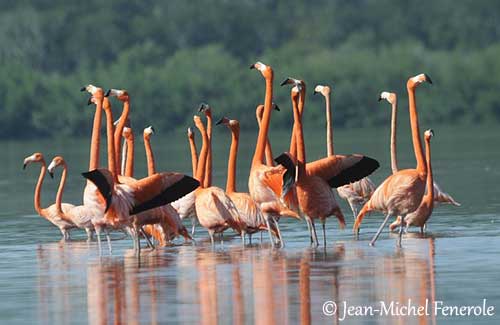
Before and during the breeding season, the American Flamingo performs several types of displays. Several months before breeding, they spend much time to perform collective displays, carried out by numerous birds. These displays include series of ritualized postures and movements. These displays are performed by a highly synchronized flock. Head movements, wing displays and vocalizations are a large part of this ritual during which male and female also court each other.
They appear to be monogamous with strong, long-term pair-bonds. Copulation occurs after the pair has left the flock. Some displays occur, prior to copulation. They are less conspicuous than the communal displays, and often take place at other sites than the eventual breeding grounds.
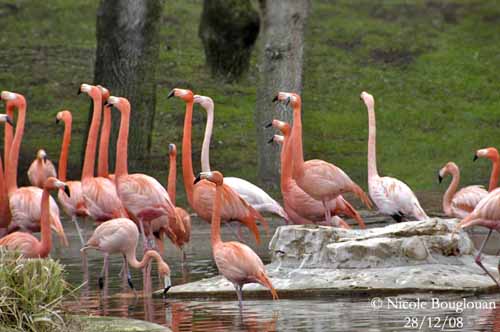
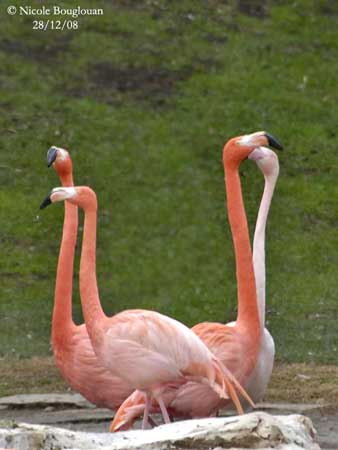
The American Flamingo of the race “glyphorhyncus” from Galapagos Islands is sedentary.
The nominate race “ruber” performs movements between the colony in the Bahamas and Cuba and Hispaniola. The Mexican population which breeds in Yucatan Peninsula usually winters in the Celestun Estuary, at about 280 km to the west. Numerous birds breeding on Bonaire Island perform post breeding dispersion along the coast of Venezuela, also W into Colombia, and E to the Amazon Estuary. These trips are due to lack of food on Bonaire Island.
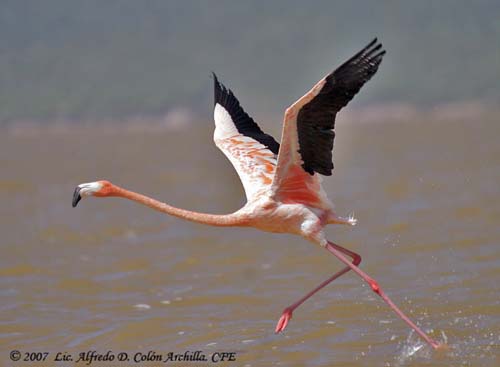
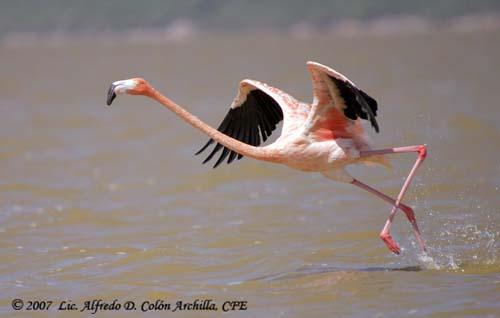
The American Flamingo performs swift and direct flight with rapid wingbeats. When in flock, they fly in straight line or in typical V formation. This large bird needs a short run up to take-off, while flapping its wings. It flies with the neck outstretched and may perform short glides interspersed with wing-flapping periods. Before the landing, the flamingo makes a long glide before to touch the ground where it runs over some metres.
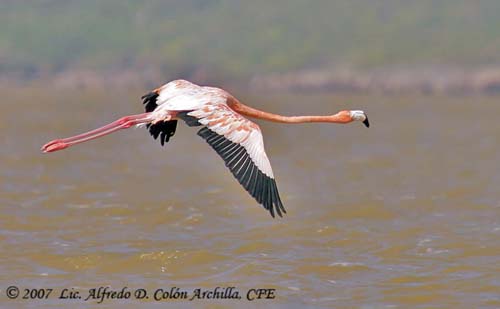
REPRODUCTION OF THIS SPECIES:
The breeding season takes place in May in Mexico and between March and June in the Bahamas, but this period may vary.
The American Flamingo breeds in large colonies often established along lagoons and saline or alkaline lakes where the vegetation is lacking, and replaced by desert-like ground.
The nest is a mound of mud of about 30 cm height, in the form of a truncated cone. There is a shallow depression on top. Both sexes build the nest and share the incubation of the single chalky white egg, rarely two, during about 28-30 days.
At hatching, the downy chick is grey and has straight bill. It is fed by both parents with the typical “milk” secreted in the upper digestive tract of the adults.
The chick is brooded during about 5-15 days. Then, it joins up with other chicks, forming large crèches which are looked after by a few adults. It fledges about 70-75 days after hatching. At this stage, the bill has the typical bent shape, allowing it to filter the mud and to feed itself.
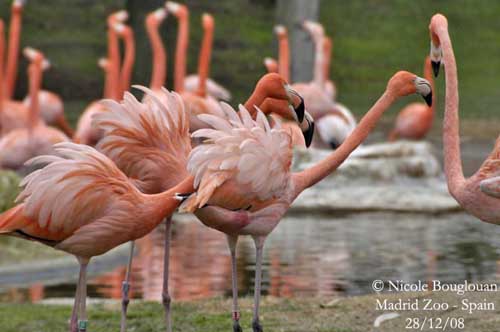
PROTECTION / THREATS / STATUS:
After marked decline in 1956, the populations of the American Flamingo have increased and appear stable, like the Galapagos Flamingo’s populations too.
However, they are threatened by habitat loss and human disturbance along the coastal wetlands of Caribbean. But currently, this species is not threatened.
